J Sainsbury Bundle
How is Sainsbury's winning in the UK retail game?
J Sainsbury Company's journey from a small London dairy to a UK retail giant is a testament to its evolving sales and marketing strategies. Facing fierce competition, Sainsbury's has strategically prioritized value and customer loyalty, investing heavily in price and loyalty programs. The 'Next Level Sainsbury's' strategy, launched in early 2024, underscores this commitment to becoming the 'First Choice for Food' retailer.
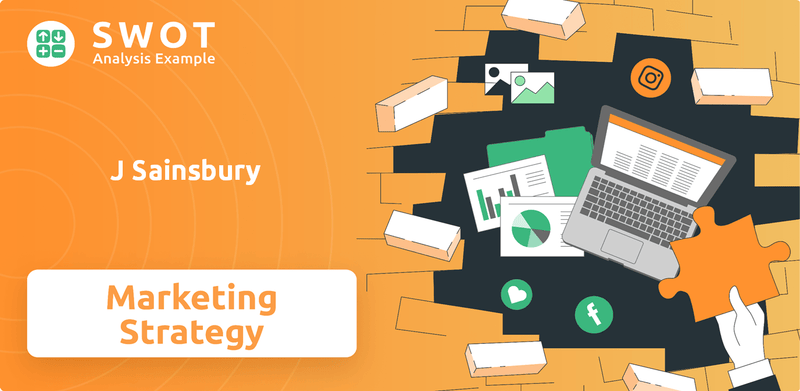
This deep dive into Sainsbury's J Sainsbury SWOT Analysis will dissect its sales strategy, examining how it navigates the competitive landscape through strategic pricing and promotional efforts. We'll explore Sainsbury's marketing strategy, including its digital marketing strategy, social media campaigns, and brand positioning, and how it leverages customer data for targeted marketing. Furthermore, we will analyze Sainsbury's business model, retail strategy, and market analysis to understand its success in the UK grocery market, including its sales performance review and customer relationship management (CRM) tactics. This will include a look at Sainsbury's supply chain marketing strategy and sustainability marketing initiatives, providing a comprehensive overview of its approach.
How Does J Sainsbury Reach Its Customers?
The sales strategy of J Sainsbury Company is multifaceted, employing a blend of physical and digital channels to engage its customer base. This approach, central to its marketing strategy, aims to provide a seamless shopping experience across various touchpoints. The company's diverse channels are a key element of its retail strategy, designed to meet evolving consumer preferences and market dynamics.
Sainsbury's leverages its extensive network of supermarkets and convenience stores, alongside a robust online presence, to maximize market reach. The integration of Argos, both online and in-store, further enhances its sales capabilities. This omnichannel approach is a core component of Sainsbury's business model, supporting its goal of sustained growth and customer satisfaction.
The company's sales and marketing efforts are continually evolving to adapt to changing consumer behaviors and market trends. With a focus on digital innovation and strategic partnerships, Sainsbury's aims to strengthen its market position and deliver value to its shareholders. This comprehensive strategy is crucial for navigating the competitive landscape, as detailed in an analysis of the Competitors Landscape of J Sainsbury.
Sainsbury's operates a vast network of physical stores, including over 600 supermarkets and approximately 800 convenience stores across the UK. The strategic integration of Argos, with shop-in-shops and collection points, complements this network. By March 2024, Argos had nearly 660 stores, including standalone stores and those within Sainsbury's, plus numerous collection points.
Online sales are a critical part of Sainsbury's sales strategy, especially post-COVID-19, with over 70% of Argos sales originating online. The company provides e-commerce platforms and home delivery services. Sainsbury's is enhancing its online food ordering capabilities and plans to relaunch 'Occasions by Sainsbury's' in late 2024.
The company plans to open around 75 new Sainsbury's Local convenience stores over the next three years. Investment is planned for approximately 180 of its highest potential supermarkets to stock the full food range. These initiatives are part of Sainsbury's 'Next Level' strategy, focusing on omnichannel integration and enhanced customer experience.
Sainsbury's Bank also provides financial services, further diversifying its offerings and enhancing customer loyalty. This integration of financial products with its retail operations is a key part of Sainsbury's overall strategy. The bank's services contribute to the company's revenue streams.
Sainsbury's sales and marketing strategy focuses on omnichannel integration, leveraging both physical and digital channels. This approach aims to provide a seamless shopping experience and cater to changing consumer preferences. The company's strategy includes strategic partnerships and investments in digital capabilities.
- Strategic Integration: Combining physical stores with online platforms.
- Digital Enhancement: Improving e-commerce and home delivery services.
- Customer Experience: Focusing on a seamless shopping experience.
- Expansion Plans: Opening new convenience stores and upgrading supermarkets.
J Sainsbury SWOT Analysis
- Complete SWOT Breakdown
- Fully Customizable
- Editable in Excel & Word
- Professional Formatting
- Investor-Ready Format
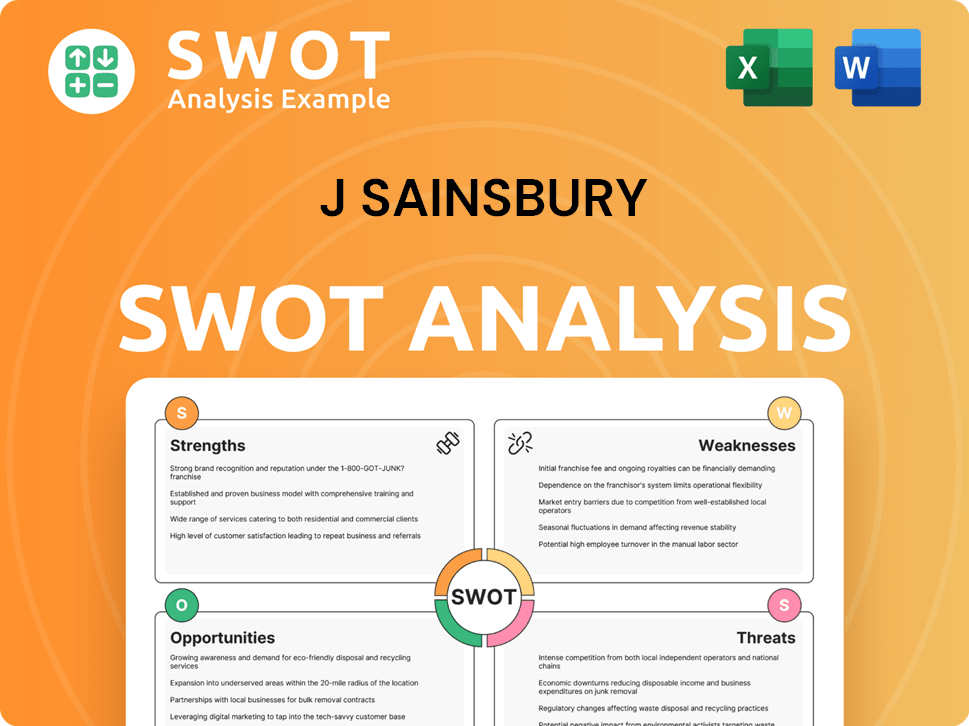
What Marketing Tactics Does J Sainsbury Use?
The company employs a comprehensive approach to its sales and marketing strategy, integrating both digital and traditional methods to boost brand recognition, attract potential customers, and ultimately, drive sales. This strategy is heavily influenced by data analytics and customer relationship management (CRM), with a strong emphasis on personalization and loyalty programs. The goal is to achieve food volume growth ahead of the market under its 'Next Level' strategy.
The company's marketing tactics are designed to build a world-leading loyalty platform and provide personalized offers through its Nectar program. This customer-centric strategy is supported by substantial investment in data-driven marketing techniques. The company's approach includes a mix of online and offline advertising and promotional activities.
A key component of the company's sales and marketing strategy is its commitment to cost savings, aiming for £1 billion in savings over three years, up to FY27. This focus on efficiency, combined with targeted marketing campaigns, is intended to improve profitability and market share. The company's marketing efforts are constantly evolving to meet the changing needs of its customers and the competitive landscape.
The company utilizes social media platforms like Facebook, where it has over 1.8 million followers, to engage with customers and build brand awareness.
Email marketing is used for personalized offers and promotions based on customer preferences and behaviors. Data-driven marketing is a key focus, with the Nectar loyalty program at its core.
The Nectar program has over 16 million digital subscribers. It generates over 260 million personalized offers weekly.
Customers save an average of £12 off their weekly £80 shop through initiatives like Nectar Prices. The company invested £70 million in personalized pricing algorithms and machine learning.
The company is expanding its retail media offering, Nectar 360, to gain greater access to innovation and insights.
This expansion is a strategic move to leverage data and enhance marketing capabilities.
The company uses above-the-line (ATL) and below-the-line (BTL) advertising techniques, including TV, radio, print media, billboards, and leaflets.
The official website serves as a key promotional tool, regularly uploading product information and promotional activities.
The marketing mix emphasizes building a world-leading loyalty platform and personalized offers through Nectar.
This evolution reflects a customer-centric approach focused on data-driven insights and personalized experiences.
The company aims to achieve food volume growth ahead of the market under its 'Next Level' strategy.
It is targeting profit leverage from sales growth while focusing on cost savings, with a commitment to £1 billion of cost savings over three years to FY27.
The company's sales strategy focuses on leveraging customer data, expanding its retail media capabilities, and integrating digital and traditional marketing channels. This data-driven approach, highlighted in a recent article about the company's business model, is central to its success.
- Data-Driven Marketing: Utilizing the Nectar loyalty program to personalize offers and promotions.
- Digital Engagement: Leveraging social media and email marketing for customer interaction.
- Retail Media: Expanding Nectar 360 to gain insights and innovation.
- Cost Efficiency: Implementing cost-saving measures to improve profitability.
J Sainsbury PESTLE Analysis
- Covers All 6 PESTLE Categories
- No Research Needed – Save Hours of Work
- Built by Experts, Trusted by Consultants
- Instant Download, Ready to Use
- 100% Editable, Fully Customizable
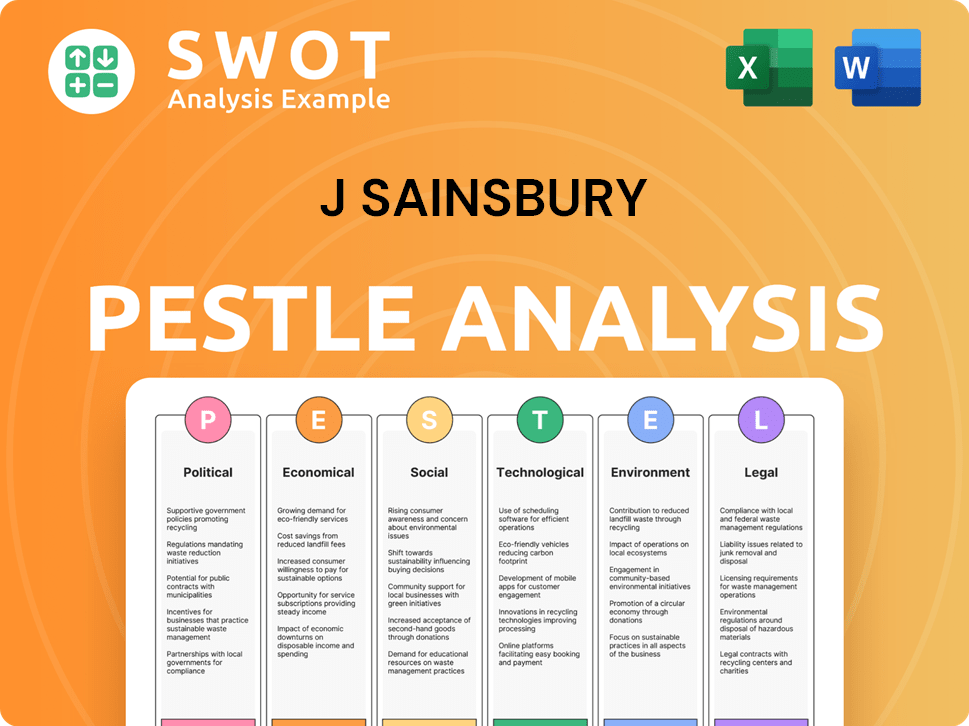
How Is J Sainsbury Positioned in the Market?
The brand positioning of J Sainsbury centers on providing 'good food joyful, accessible, and affordable for everyone, every day.' This core message, articulated in its 'Next Level Sainsbury's' strategy launched in February 2024, aims to differentiate the company from competitors. This approach emphasizes both quality and value, contributing to a 0.4 percentage point increase in its market share, according to recent reports.
Sainsbury's positions itself as the 'First Choice for Food,' aiming to attract customers to its stores and play a leading role in creating a sustainable food system in the UK. Historically, the stores featured consistent visual elements, such as marble counters and mosaic floors, to build recognition. The company focuses on delivering outstanding value, unbeatable quality food, and great service across all channels to maintain a consistent customer experience.
The company primarily targets families, offering an extensive range of products at affordable prices while maintaining high standards. Sainsbury's has improved its value perception faster than competitors, with customer satisfaction and availability at record levels. The premium 'Taste the Difference' range has been particularly successful, with an 18% increase in sales in the six months to September 2024, resonating with consumers seeking affordable luxury. This strategy is a key component of its overall Revenue Streams & Business Model of J Sainsbury.
The core message revolves around being the 'First Choice for Food,' aiming to attract more customers. This is a key part of their Sales strategy Sainsbury's, focusing on quality and value.
The primary target audience is families, offering a wide range of products at affordable prices. This helps to define their Sainsbury's target audience demographics.
Sainsbury's emphasizes sustainability, pledging £1 billion over fifteen years to become a Net Zero business by 2035. This commitment is a key aspect of their Sainsbury's sustainability marketing initiatives.
Launched in April 2024, the 'Good to Know' campaign highlights sustainability efforts, including responsible sourcing. This is an example of their Sainsbury's marketing campaigns examples.
J Sainsbury Business Model Canvas
- Complete 9-Block Business Model Canvas
- Effortlessly Communicate Your Business Strategy
- Investor-Ready BMC Format
- 100% Editable and Customizable
- Clear and Structured Layout
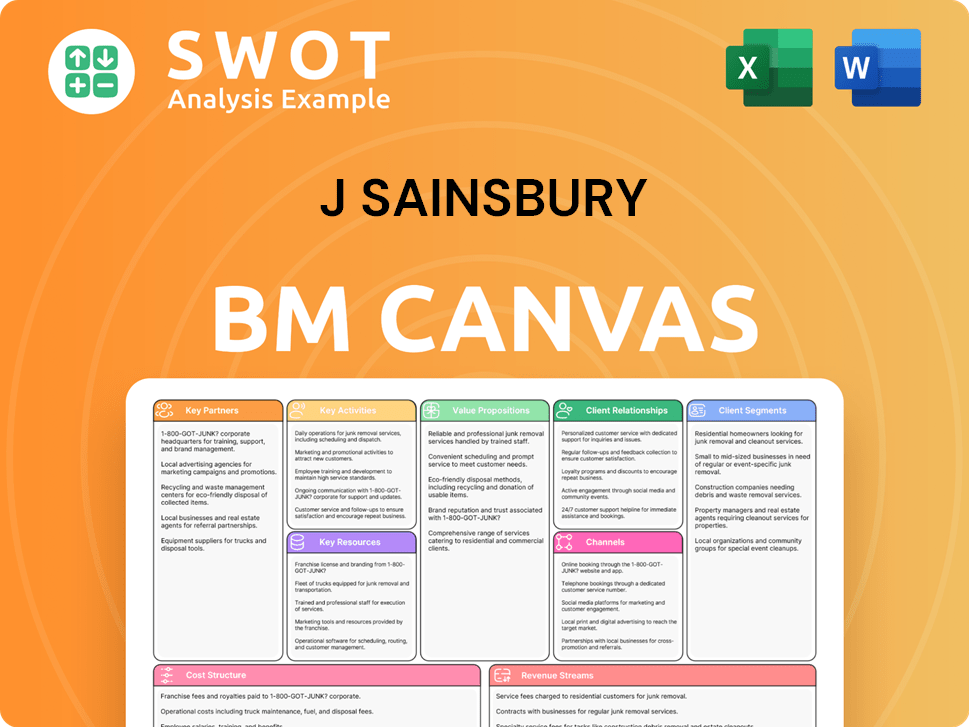
What Are J Sainsbury’s Most Notable Campaigns?
The sales and marketing strategy of the company revolves around impactful campaigns designed to boost customer loyalty and drive sales. These initiatives are crucial for maintaining a strong market position and adapting to the evolving retail landscape. The company leverages data-driven insights and a commitment to sustainability to resonate with consumers.
One of the key pillars of this strategy includes personalized value through its loyalty program. Simultaneously, the company is actively promoting its sustainability efforts, showcasing its commitment to ethical sourcing and environmental responsibility. These campaigns highlight the company's dedication to providing value and addressing consumer preferences.
Launched in September 2023, the 'Nectar Prices' campaign offers personalized discounts. It leverages the Nectar loyalty program, which has over 16 million digital subscribers. Customers save an average of £13 per week, with a total of £2 billion in savings over the past year.
Launched in April 2024, this campaign focuses on sustainability efforts. It highlights initiatives across the supply chain, including ethical sourcing and reduced food waste. The campaign uses in-store promotions, packaging updates, and a radio campaign to communicate these efforts.
In March 2025, the company announced that it would be transforming food waste into biofuel for 30 of its HGV trucks. This initiative is projected to save over 3,000 tonnes of carbon dioxide annually, demonstrating its commitment to reducing its environmental impact.
In 2024, the company confirmed it would pay its contribution to support banana workers in earning a living wage three years ahead of the industry deadline. This action underscores its dedication to Fairtrade and ethical sourcing practices, aligning with its broader sustainability goals.
The company's sales strategy Sainsbury's and marketing strategy Sainsbury's are heavily influenced by data-driven personalization and sustainability efforts. These campaigns, such as 'Nectar Prices' and 'Good to Know', are central to Sainsbury's sales and marketing approach.
- The 'Nectar Prices' initiative uses the Nectar loyalty program to offer personalized discounts, boosting customer loyalty and driving sales.
- The 'Good to Know' campaign highlights the company's sustainability efforts, appealing to environmentally conscious consumers.
- Sustainability initiatives, like converting food waste to biofuel, demonstrate the company's commitment to environmental responsibility.
- Ethical sourcing practices, such as supporting Fairtrade, further enhance the company's brand image.
J Sainsbury Porter's Five Forces Analysis
- Covers All 5 Competitive Forces in Detail
- Structured for Consultants, Students, and Founders
- 100% Editable in Microsoft Word & Excel
- Instant Digital Download – Use Immediately
- Compatible with Mac & PC – Fully Unlocked
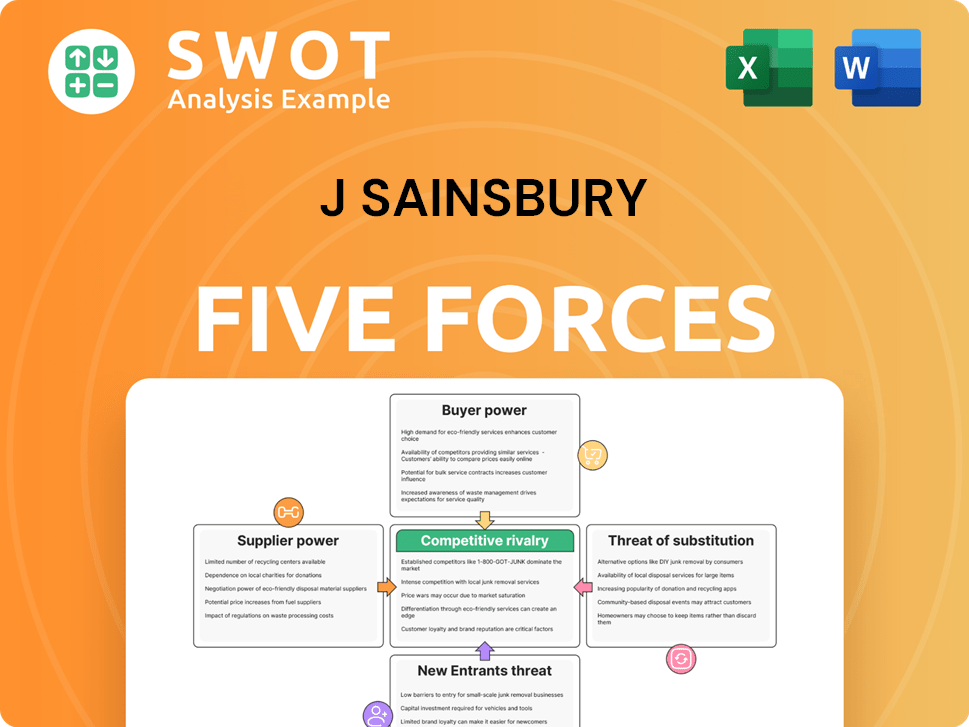
Related Blogs
- What are Mission Vision & Core Values of J Sainsbury Company?
- What is Competitive Landscape of J Sainsbury Company?
- What is Growth Strategy and Future Prospects of J Sainsbury Company?
- How Does J Sainsbury Company Work?
- What is Brief History of J Sainsbury Company?
- Who Owns J Sainsbury Company?
- What is Customer Demographics and Target Market of J Sainsbury Company?
Disclaimer
All information, articles, and product details provided on this website are for general informational and educational purposes only. We do not claim any ownership over, nor do we intend to infringe upon, any trademarks, copyrights, logos, brand names, or other intellectual property mentioned or depicted on this site. Such intellectual property remains the property of its respective owners, and any references here are made solely for identification or informational purposes, without implying any affiliation, endorsement, or partnership.
We make no representations or warranties, express or implied, regarding the accuracy, completeness, or suitability of any content or products presented. Nothing on this website should be construed as legal, tax, investment, financial, medical, or other professional advice. In addition, no part of this site—including articles or product references—constitutes a solicitation, recommendation, endorsement, advertisement, or offer to buy or sell any securities, franchises, or other financial instruments, particularly in jurisdictions where such activity would be unlawful.
All content is of a general nature and may not address the specific circumstances of any individual or entity. It is not a substitute for professional advice or services. Any actions you take based on the information provided here are strictly at your own risk. You accept full responsibility for any decisions or outcomes arising from your use of this website and agree to release us from any liability in connection with your use of, or reliance upon, the content or products found herein.